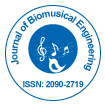Editorial Open Access
Music in Science and Medicine
Dorita S. Berger*
PhD, Durham, NC, USA
- Corresponding Author:
- Dorita S. Berger
Therapist, The Music Therapy Clinic
Norwalk, USA
Tel: +44 (020)78332307
E-mail: dsberger@mags.net
Received Date: April 10, 2015; Accepted Date: April 13, 2015; Published Date: April 15, 2015
Citation: Berger DS (2015) Music in Science and Medicine. J Biomusic Eng 3:e106. doi:10.4172/2090-2719.1000e106
Copyright: © 2015 Berger DS. This is an open-access article distributed under the terms of the Creative Commons Attribution License, which permits unrestricted use, distribution, and reproduction in any medium, provided the original author and source are credited.
Visit for more related articles at Journal of Biomusical Engineering
Abstract
Music, by any definition, has been part of human life since the beginning of bipedalism, and maybe even before that. Now, in our 21st Century, there is not a day that goes by without music and without the myriad of technologies to help even an infant be exposed to this aesthetic form of communication. Music is energy, emotion, vibration, infiltrating our sensory systems, emotions, and whole bodies. And, with the development of current technologies, music has a far reaching effect for composers developing unimaginable sounds and expressions and listener seeking the best devices for enjoying music.
Editorial
Music, by any definition, has been part of human life since the beginning of bipedalism, and maybe even before that. Now, in our 21st Century, there is not a day that goes by without music and without the myriad of technologies to help even an infant be exposed to this aesthetic form of communication. Music is energy, emotion, vibration, infiltrating our sensory systems, emotions, and whole bodies. And, with the development of current technologies, music has a far reaching effect for composers developing unimaginable sounds and expressions and listener seeking the best devices for enjoying music.
Research on music in the sciences and medicine is finally reaching the forefront of attempts to understand the brain, cognition, physiology, and emotional behaviors. As a result of the birth of such scientific and engineering music explorations, this unique Journal of Biomusical Engineering has been put forth as a new platform for researchers and philosophers in and about music in human adaptation, to publish their thoughts and findings and reach a whole new, cross-modal audience of readers. This Journal especially provides an opportunity for younger researchers to present their work in an International journal that welcomes and nurtures fresh new ideas, thoughts, approaches to understanding the phenomenon of music in human existence. From Music Anthropology to Musicology, from Music Composition and expression to Music-based Treatment modalities, the Journal of Biomusical Engineering is the only on-line, free-access publication giving voice to an amalgam of researchers in Music and Physiologic Function, Music and Technology, Music in Treatment, Music in Cultural Expression, Music and Emotion, Music in history, and all areas of music in human behaviors.
In a century in which information instantly reaches across the planet, in which internet search engines provide immediate results and connection, in which knowledge is obtainable while one sits in the comfort of one’s home, at one’s desk or couch, this free, open-access Journal brings current new ideas, issues, discussion, presentations to readers who want to think along new lines, far from the same ‘ol same ‘ol, as our children like to say. Music neuroscience, music therapy, music and physiologic function, music and technology, music and psychology and psychiatric medicine, music as a way of life, and many other topics on music exploration, can be found in this Journal of Biomusical Engineering, that brings together and amalgamates a variety of interests. There is no Journal quite like this one.
Some articles I would like to see included here would contain explorations on research in music and non-human lives (as in Dr. Pat Gray’s Biomusic Research), brains and function of musicians, what causes a child to be drawn to learning music, what new findings attest to the significant role of music in treatment, what is music now in this new century, and what role does it play in daily life (other than the usual distraction and mood changer), why does music still exist if we have so many other forms of entertainment, what does music contribute to human physiologic function on the cellular and molecular levels (not just brain), and so many other investigations and philosophies
This Journal reaches a wide cross-section of readers that other Journals may not, as easily, reach. That is, neuroscientists read neuroscience journals, biologists read biology journals, and so on, but by submitting to, and reading this Journal, everyone can obtain insights across the board, in addition to one’s particular professional investigations, not just limited to one single domain. This is precisely why this Journal of Biomusical Engineering was developed. It is timely. Please take a look at some previously published articles, and seriously consider proposing a piece of your own that will be peer-reviewed and discussed for possible publication.
For further information contact: http://www.omicsgroup.info/ editorialtracking/biomusical/SubmitManuscript.php.
--Relevant Topics
Recommended Journals
Article Tools
Article Usage
- Total views: 13883
- [From(publication date):
December-2015 - Aug 30, 2025] - Breakdown by view type
- HTML page views : 9169
- PDF downloads : 4714
